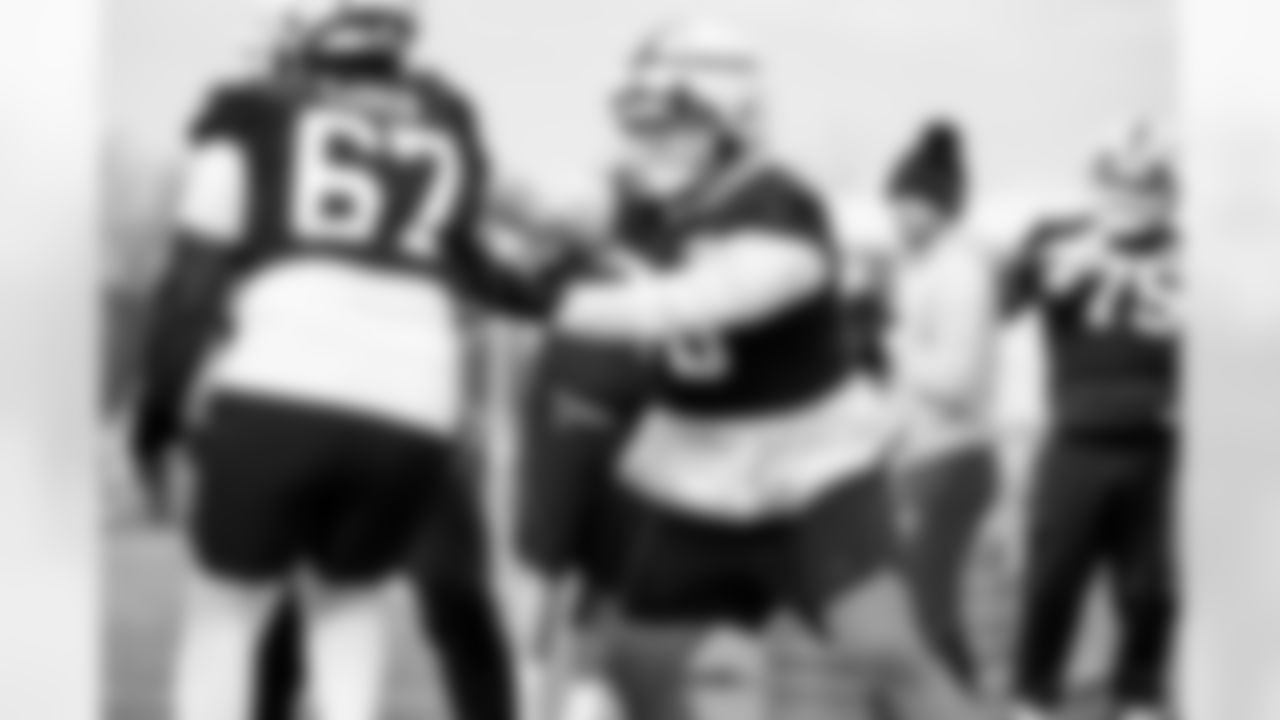Facing an offense full of playmakers and a strong-armed quarterback in Tua Tagovailoa, defensive coordinator Jim Schwartz made it clear there is one characteristic of the Dolphins offense that stands out among the rest.
Speed.
"It all sort of works together and ties into what they feel the quarterback can accomplish the best and how it matches their personnel," Schwartz said. "They have a lot of guys that sort of blur the lines of what they are – wide receiver/running back, fullback/tight end, tight end/fullback. I have been impressed, all their wide receivers will block even though not a lot of big guys out there, including Tyreek Hill, they'll block in the run game, they'll chip in pass protection. But the biggest thing this week is just being able to handle speed because they threaten all 53-and-a-third with the speed of their team."
The speed of the Miami offense is integral to their offensive identity. The Dolphins run an offensive scheme designed to get the ball out quickly, as Tagovailoa averages just 2.42 seconds per throw – the fastest rate in the NFL this season.
Tagovailoa's speedy pass catchers – in particular Hill, WR Jaylen Waddle and RB Devon Achane – enable him to get the ball out on time while also holding the highest completion percentage in the NFL at 72.9 percent.
Hill and Waddle are among the fastest receiver duos in the NFL. Hill and Eagles RB Saquon Barkley are the only two ball carriers to record top speeds of 21.5 or more miles per hour over the past two seasons. Waddle has also shown his elite speed, reaching a career-high 21.68 miles per hour in Week 16 of the 2022 season. Achane has two carries for over 21.70 miles per hour in the last two seasons, trailing only Barkley, who has three.
Speed has been a trait of Hill's skillset since he entered the league nine seasons ago, and he remains a lethal threat in the open field according to CB Denzel Ward. His shiftiness and speed have made him an elite receiver, recording 864 receiving yards and six receiving touchdowns this season.
"He's still a great player, a fast player," Ward said. "You get the ball in his hands, he's dangerous. We have to try to find a way to limit that and do it the best we can."
Check out photos of the team working to prepare for their game this week against the Miami Dolphins at CrossCountry Mortgage Campus


Defensive end Myles Garrett (95) during practice at CrossCountry Mortgage Campus on December 26, 2024.

Defensive tackle Mike Hall Jr. (51) during practice at CrossCountry Mortgage Campus on December 26, 2024.

Quarterback Dorian Thompson-Robinson (17) during practice at CrossCountry Mortgage Campus on December 26, 2024.

Linebacker Jordan Hicks (58) during practice at CrossCountry Mortgage Campus on December 26, 2024.

Offensive guard Joel Bitonio (75) during practice at CrossCountry Mortgage Campus on December 26, 2024.

Safety Rodney McLeod Jr. (12) during practice at CrossCountry Mortgage Campus on December 26, 2024.

Defensive end Isaiah McGuire (57) during practice at CrossCountry Mortgage Campus on December 26, 2024.

Cornerback Martin Emerson Jr. (23) during practice at CrossCountry Mortgage Campus on December 26, 2024.

Wide receiver James Proche II (11) during practice at CrossCountry Mortgage Campus on December 26, 2024.

Safety Chris Edmonds (41) during practice at CrossCountry Mortgage Campus on December 26, 2024.

Defensive end Myles Garrett (95) during practice at CrossCountry Mortgage Campus on December 26, 2024.

Cornerback Myles Harden (26) during practice at CrossCountry Mortgage Campus on December 26, 2024.

Safety Trey Dean (28) during practice at CrossCountry Mortgage Campus on December 26, 2024.

Defensive tackle Jowon Briggs (97) during practice at CrossCountry Mortgage Campus on December 26, 2024.

Safety Ronnie Hickman Jr. (33) during practice at CrossCountry Mortgage Campus on December 26, 2024.

Safety Chris Edmonds (41) during practice at CrossCountry Mortgage Campus on December 26, 2024.

Safety D'Anthony Bell (37) during practice at CrossCountry Mortgage Campus on December 26, 2024.

Running Backs Coach Duce Staley during practice at CrossCountry Mortgage Campus on December 26, 2024.

Linebacker Winston Reid (59) during practice at CrossCountry Mortgage Campus on December 26, 2024.

Safety Grant Delpit (9) during practice at CrossCountry Mortgage Campus on December 26, 2024.

Running back Pierre Strong Jr. (20) during practice at CrossCountry Mortgage Campus on December 26, 2024.

Quarterback Jameis Winston (5) during practice at CrossCountry Mortgage Campus on December 26, 2024.

Quarterback Dorian Thompson-Robinson (17) during practice at CrossCountry Mortgage Campus on December 26, 2024.

Cornerback Cameron Mitchell (29) during practice at CrossCountry Mortgage Campus on December 26, 2024.

Defensive end Myles Garrett (95) during practice at CrossCountry Mortgage Campus on December 26, 2024.

Running Backs Coach Duce Staley during practice at CrossCountry Mortgage Campus on December 26, 2024.

Wide receiver James Proche II (11) during practice at CrossCountry Mortgage Campus on December 26, 2024.

Quarterback Bailey Zappe (2) during practice at CrossCountry Mortgage Campus on December 26, 2024.

Running back D'Onta Foreman (27) during practice at CrossCountry Mortgage Campus on December 26, 2024.

Offensive tackle Michael Dunn (68) during practice at CrossCountry Mortgage Campus on December 26, 2024.

Wide receiver Elijah Moore (8) during practice at CrossCountry Mortgage Campus on December 26, 2024.

Tight end Tre' McKitty (87) during practice at CrossCountry Mortgage Campus on December 26, 2024.

Running back D'Onta Foreman (27) during practice at CrossCountry Mortgage Campus on December 26, 2024.

Kicker Andre Szmyt (10) and Kicker Dustin Hopkins (7) during practice at CrossCountry Mortgage Campus on December 26, 2024.

Offensive guard Zak Zinter (70) during practice at CrossCountry Mortgage Campus on December 26, 2024.

Quarterback Dorian Thompson-Robinson (17) during practice at CrossCountry Mortgage Campus on December 26, 2024.

Offensive guard Germain Ifedi (65) during practice at CrossCountry Mortgage Campus on December 26, 2024.

Kicker Andre Szmyt (10) during practice at CrossCountry Mortgage Campus on December 26, 2024.

Tight end Tre' McKitty (87) during practice at CrossCountry Mortgage Campus on December 26, 2024.

Head Coach Kevin Stefanski during practice at CrossCountry Mortgage Campus on December 26, 2024.

Offensive Line Coach Andy Dickerson during practice at CrossCountry Mortgage Campus on December 26, 2024.

Running back Jacob Kibodi (36) during practice at CrossCountry Mortgage Campus on December 26, 2024.

Center Ethan Pocic (55) during practice at CrossCountry Mortgage Campus on December 26, 2024.

Cornerback Martin Emerson Jr. (23) during practice at CrossCountry Mortgage Campus on December 26, 2024.

Offensive tackle Lorenzo Thompson (69) during practice at CrossCountry Mortgage Campus on December 26, 2024.

Safety Grant Delpit (9) during practice at CrossCountry Mortgage Campus on December 26, 2024.

Cornerback Mike Ford Jr. (31) during practice at CrossCountry Mortgage Campus on December 26, 2024.

Running back Jacob Kibodi (36) during practice at CrossCountry Mortgage Campus on December 26, 2024.

Kicker Andre Szmyt (10) during practice at CrossCountry Mortgage Campus on December 26, 2024.
One way to limit Hill and the rest of the Dolphins pass catchers will be to avoid missing tackles.
Hill, Waddle and Achane have all proven their ability to dodge defenders and run after the catch. The Dolphins offense has the fourth-most yards after catch in the NFL with 2,182 yards, as Tagovailoa often relies on short and intermediate passes in order to escape the pass rush and get the ball in the hands of his playmakers.
"(They have) a lot of different ways just to get the ball in their playmakers' hands, whether they're wide receiver screens, running back screens or even tight end screens for run after the catch," Schwartz said. "And when you're a team that relies on run after the catch, it certainly puts an emphasis (for the defense) on tackling, angles and pursuit."
The Dolphins don't often rely on deep passes to power their offense, attempting only 30 throws over 20 yards this season – the fewest in the NFL. However, Tagovailoa has been effective when throwing the ball deep, completing 40 percent of his passes over 20 air yards – the ninth-highest completion percentage in the NFL – for 344 yards, two touchdowns and two interceptions.
S Grant Delpit said he will be on the lookout for the Dolphins' capacity for shot plays despite their proven preference for short passes.
"They can kill you short, they can lull you to sleep throwing short and then throw it long," Delpit said. "So, we have to do our job either way it goes, but we have to expect what's coming."
With the Dolphins likely to continue implementing the quick pass game against the Browns, Schwartz said athletic play from his defensive line would be critical in eliminating explosive plays.
While typically defensive tackles are expected to cover the area known as the "b-gap" – the space in between the offensive guard and offensive tackle – Schwartz said the Dolphins' reliance on the screen play will force his defensive lineman to account for a much broader part of the field in Week 17.
"The way these guys play, they make you defend from the guard all the way to the sideline. So, it really puts an emphasis on forcing your D-line to be athletes," Schwartz said. "They're going to have to be able to chase on some of these quick perimeter screens. […] Having that defensive line's pursuit inside out and them being available as an extra layer is a necessity this week. It's not a bonus; it's a necessity based on the way they play."















